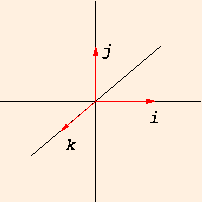
| (prev) | (top) | (next) |
Position, velocity and acceleration are all vectors. We will denote vectors in red bold type in these notes.
The vector from the point u to the point v is v - u.
The length (or magnitude)
of a vector V is
vy = V sin φ.
See this applet for examples.
Vectors
V = (vx, vy, vz)
where i, j and k are unit vectors (of length 1) in the x, y and z directions, respectively. If
i and j are in their usual positions in the plane of the page, the direction of k is out of the page, pointing towards you:
= vx i + vy j + vz k,

U ± V = (ux ± vx, uy ± vy, uz ± vz).
It is often called the resultant.
U ⋅ V ≡ ux * vx + uy * vy + uz * vz
Note that it is zero if U and V are
perpendicular. Think of the dot product as the component of U along the direction of V, times the magnitude of V.
V ≡ |V| = √ (V ⋅ V).
V / V is the unit vector in the direction of V.
Note that the sum of vector magnitudes is in general meaningless.
vx = V cos φ, and
Note that tan φ = vy / vx.
Note that these equations are only valid for φ measured counterclockwise from the positive x axis. If you label a
different angle as φ, you may have vx = V sin φ, etc.
In general, the length of a vector is the length of the hypotenuse of a right triangle whose sides are the vector components:


| (prev) | (top) | (next) |
©2010, Kenneth R. Koehler. All Rights Reserved. This document may be freely reproduced provided that this copyright notice is included.
Please send comments or suggestions to the author.